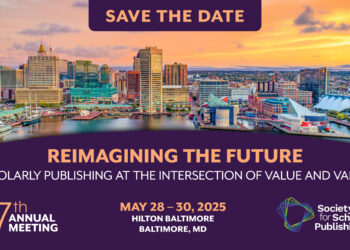
At last week’s Charleston Conference, I was asked to participate in a panel discussing the topic of trust — how it’s created, maintained, and potentially weakened. The panel was constructed so that there was a publisher, a researcher, a librarian, and a vendor, with each providing his or her perspective on the matter. I learned a lot from the other speakers, but was asked after the conference by a few people to write out the gist of my presentation as a post here.
Here is the written version of the talk.
I think there is a range to trust — trust isn’t binary, a simple comparison between trust and distrust. At one extreme, there are people and information sources I would trust with my life. At the other extreme, there are people I wouldn’t trust as far as I could throw them. And in between, there are sources and people who I trust to a point, but they’ll require backup before I really trust what they say. This is the famous, “Trust, but verify,” stance President Reagan took in the 1980s.
You end up with a spectrum of Throw – Verify – Life.
Along this spectrum, where do the participants in bringing research to light fall?
- Authors — While it’s politically correct to say that “we trust our authors,” the fact is that we hold this statement over their heads like the proverbial Sword of Damocles. Meanwhile, we behave as if we distrust them, a state created by being burned so many times before by author misadventures. So, we require disclosure of commercial interests and attestation to actual authorship. These are not things you require of people you trust. Consequently, authors are generally somewhere between the “Throw” and “Verify” points of the spectrum I’m using.
- Sponsors — Commercial sponsors are clearly the most problematic and more toward the “Throw” end of the spectrum, but even apparently philanthropic sponsors deserve some scrutiny. They can have political or social agendas driving their funding with indirect conflicts or shadow funding driving their choices. Therefore, I put sponsors just to the left of authors, a little more toward the “Throw” side of the spectrum.
- Editors — Editors are an interesting bunch for publishers. We trust them, but also know that their tenures are unpredictable and finite, while the identity of their role is more permanent. Therefore, we watch them a bit. Most are fantastic partners in brand management, editorial advancement, and business propriety, but there have been cases of editors going off the reservation, so to speak, and abusing their positions for the sake of cronyism or personal egotism. I put editors closer to the “Verify” line, but not across it entirely.
- Peer Reviewers — Authors, especially spurned authors, often show distrust of peer reviewers and even the process they are part of. Publishers and editors also trust peer reviewers only so far — if two disagree, we seek a third or probe further or both. We ask them to disclose conflicts, to recuse themselves when appropriate, and so forth. The trust in peer reviewers is about the same as it is for authors.
Aside from these four main players, there are journalists and policy makers, both of which lie again between the “Throw” and “Verify” points on the spectrum.
So, if there is so much distrust in generating any particular piece of scholarly content, how is it that we trust so much of it? Because distrust is part of testing materials for trustworthiness — skepticism is inherent to science. Taking that further, we trust the process writ large. That is, we trust our distrust to a high degree. And we trust the brands that are emblematic of this process, especially those that do it particularly well and reliably.
Therefore, the risk to trust lies at two points — brand and process. And this is where my concern about how we’re conducting ourselves comes in. Are we careful stewards of our brands? Are we managing the underlying process while remaining conscious of the implicit promise we have with our audiences and ultimately with the public?
Can one shift too many lead to a precipitous loss of trust?
This isn’t fanciful thinking. Go out into the “real world,” and listen to the fatigue and cynicism around new scientific findings among the general public. Another study. Another finding. Fish is heart-healthy. Mercury in fish will kill you. Texting while driving is dangerous. States that ban texting see no decrease in traffic fatalities. What’s to be believed? Combine this much more open battle of scientific findings with the pseudoscience being offered by financially or politically motivated entities, and the realm of trust around science is already fairly polluted.
Yet, we continue to put strong brands representing an understood process on top of new ventures with variant processes. And this strikes me as risky in a grand sense.
PLoS has done it, placing the PLoS brand atop two traditional journals along with another non-specific journal with different acceptance criteria and publishing practices.
BMJ is doing it, stretching the BMJ brand to encompass not only BMJ but also books, a “cases” journal, and an OA journal, each with a different process for publication.
Nature teeters on the edge, publishing specialty journals along with Nature Communications, which uses traditional peer-review but has different acceptance criteria.
This brings us to the vaunted “Spandex Principle,” which states simply, “Just because you can, doesn’t mean you should.” (Props to MB for reminding me of this important principle.)
At the same time that brands are stretching to encompass more ways to publish, thereby stretching their promises and credibility, the literature itself is expanding. More papers are being generated, more of those are being accepted — yet, a lower percentage are being cited. So, the trend itself is for researchers to ignore more of the literature. Yet we continue to push more into the system.
One of the newer criteria being accepted as valid is the “methodologically sound” criteria. Phil Davis recently posted about this, while I, in a discussion at another meeting, heard a prominent scientist admit that even this seemingly objective measure is full of subjective criteria — interest, novelty, appropriateness, and so forth. Yet, to rationalize publishing more papers, usually in an author-pays model, some publishers trot this out as if it’s Kevlar when it’s really just more Spandex.
We are stretching the genre of scientific communication to the point of absurdity. On local levels, brands are being used to dress this expansion in what seems a comfortable and compliant fabric, but from the outside reveals unpleasant bulges and irregularities. Overall, the effect is one of rapacious consumption and boundless excess.
We can’t be self-congratulatory about where we’re taking publishing right now. We’re making money feeding the “publish or perish” machines at universities, which are being fed by friendly funding entities, which are subject to political whims. Those whims are about to change, and after the proper period of latency, the level of output (from the UK, the US, and other economies) will likely fall. Is this the only remaining filter on scientific communication — a gross funding filter? Or are we playing our part in filtering information, cementing trust with the public, ensuring a correct process, and building brands that have fidelity to their promises?
If we continue to let the process drift and our brands stretch, we might realize that even Spandex has load-bearing tolerances. When that seam splits, I don’t want to be anywhere in the vicinity.
And if we drift from earned trust — trust generated by skepticism overcome — to assumed trust, then we are asserting something different. We are asserting faith.
Discussion
6 Thoughts on "Where Trust Is Built and How It Can Be Destroyed — A Publisher’s Perspective"
Perhaps I am an outlier but publishing brands mean nothing to me. I go into the literature when I have a research problem, using search engines. Name disambiguation for example. I look at the research, not where it was published. Thus I would like to see everything published, in case I need it.
Mind you I do not deal with topics where fraud is an issue, nor life and death. I assume everyone is honest going in, just as in life. If not it will show up soon enough.
I think you are something of an outlier. Nearly every scientist I know has a list of journals that they regularly check in on, journals they trust and know publish quality work relevant to their field. Nearly all would have an answer for you if you asked them, “what’s your favorite journal?” They do rely on saved searches as well, but there also seems to be a practice of “making the rounds”. Probably a good idea to allow some serendipity, to find some interesting ideas that might not turn up in a directed search.
Also, as Kent notes in the post above, skepticism is inherent to science. We are generally trained to not believe a single word anyone says until they back it up with evidence. I do try to go in with the viewpoint that the author is honest and their work is potentially of value, but I do require them to prove it. There’s a difference between requiring proof and assuming everyone is dishonest.
Your scientists probably work in well defined fields with well defined journals. Lucky them. I work in the science and technology of search, and more broadly the diffusion of knowledge. We got no journals, not yet anyhow, even though this is arguably one of the most important fields emerging. Hence my seeming eclecticism.
Then too this may be the difference between basic and applied research. We are in more of a “make it work” mode, where evidence is not a big issue. That is why I left academia in the first place. I discovered how sentences fit together but my colleagues were not disposed to believe me. I did not feel like making a career out of convincing them, when there was work to be done. Perhaps this is the essence of the basic-applied divide.
I enjoyed your talk at the conference, Kent, and I’m glad you wrote it up here.
Your perspective here obviously reflects the sector in which you operate, STM journal publishing. Much of what you say applies to scholarly book publishing also, but perhaps with some twists and extra nuances.
E.g., your list of four participants, if it were to apply to book publishing, should also include in-house staff acquiring editors and the faculty members who serve on editorial boards of university presses, both of whom play major roles in the process of filtering and decisionmaking that occurs in this sector. And, indeed, these two additional participants also have to be trustworthy for the system to work properly, and that doesn’t always happen. Some faculty members, in my experience, allow their biases to influence their judgments too much, and some staff editors manipulate the system in ways that are less than laudable.
As a response to David, I would emphasize that the brand of a university press is important both to academic libraries and to promotion-and-tenure committees, because both can be assured that books published by AAUP-member presses, at least, all must go through a rigorous peer-review process (involving more than just external expert readers) that guarantees a certain measure of reliability in the product.



